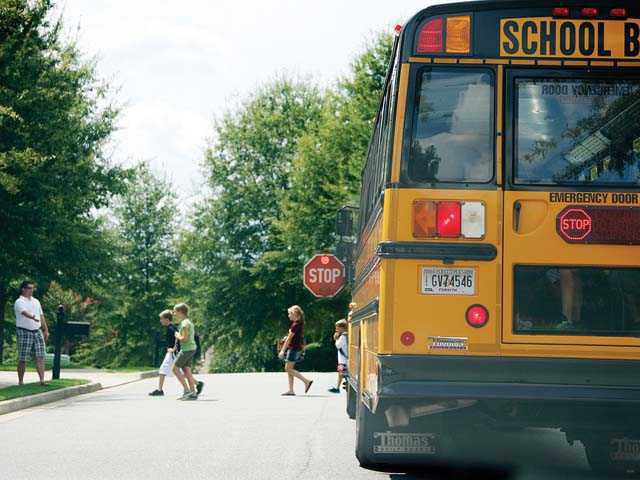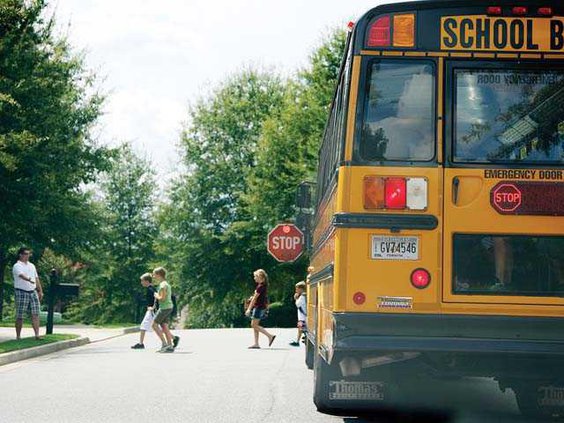School bus drivers like Elizabeth Suess use a litany of safety measures to protect the precious cargo they ferry.
And they rely on the motorists with whom they share the road to do the same.
At the start of the 2011-12 school year on Aug. 11, the Forsyth County school system had 288 school buses and drivers hauling about 24,468 students along local roads.
Perhaps it’s little surprise then that Suess said the first few days of a school year can be a shock for other motorists.
“The frustrating thing is with the road construction [on Old Atlanta Road] the motorists are confused here,” said Suess, whose afternoon route starts at Sharon Elementary School. “They don’t know exactly what lane they’re supposed to take.”
If a recent afternoon was any indication, the students seem to adjust more quickly to a new school year than the traffic does.
Once they’ve piled onto the bus, children sit in their assigned dark blue, vinyl seats until they’ve reached their destination.
Suess said keeping a seating chart not only ensures she knows who is and isn’t riding with her from day to day, but also gives the kids a sense of ownership.
She also requires her passengers, many of whom rode her bus last year, to use “nice words or no words.”
“I have a really, really good route and just wonderful kids,” she said.
Motorists who think they don’t have time to wait the few minutes it takes for a bus to stop to load or unload passengers may want to think again.
Garry Puetz, Forsyth County Schools’ transportation director, said bus routes run from 6:30 a.m.-9 a.m. and 2:30 to 5:30 p.m.
“The major traffic law [for motorists to follow] regarding school buses is when our yellow lights start to flash and then absolutely when our red lights kick in, motorists by law are required to stop,” Puetz said.
He explained that the only roads in Forsyth County that fall under an exception to the law, because they have actual physical medians, are Ga. 400 and Freedom Parkway off Keith Bridge Road.
Otherwise, motorists must stop when they see the lights flashing atop a school bus.
“It doesn’t matter if you’re on the other side of the road, if you’re on the same side of the road, if there’s one lane,” Puetz said. “It doesn’t matter if there are 10 lanes, that’s the law unless there’s a physical median.”
The school system has about 600 routes. He said when driving during route times, motorists are encouraged to remember the acronym SOAR.
That’s short for: slow down; observe what is happening; analyze what is going on; respond defensively.
According to Puetz, local law enforcement has been visible and made it a priority to ensure buses aren’t getting passed.
In addition, cameras have been installed on buses that travel through known trouble spots in the county. Footage of anyone violating the law is sent to authorities.
That wasn’t necessary on a recent afternoon, as Suess’ route went well.
When she stopped on Mathis Airport Parkway to let kids out at Andelle Avenue, traffic on both sides of the road stopped and waited.
But safe transportation begins within an hour before the doors’ opening hiss.
Through a method known as “pre-tripping,” Suess started the afternoon, as she does every shift, with a walk around the bus before she checked under the hood.
“What we’re doing when we’re under the hood is just making sure there’s nothing that’s leaking underneath and that it looks like everything is still in place the way it’s supposed to be so that the brakes and everything are 100 percent safe for the kids,” Suess said. “If not, then we’ve got time to go visit the shop.”
Her routine continued with making sure all of the bus’s lights worked, checking the emergency exits and hatches, as well as the tires, horn, crossarm, mirrors and other mechanisms.
Once she’d determined that everything was in its proper condition, she drove to her designated spot where she and other drivers waited -- off the bus -- for students to get out of school.
“Our air conditioning is affectionately known as 20/40,” she joked. “Twenty windows down at 40 miles an hour.”

